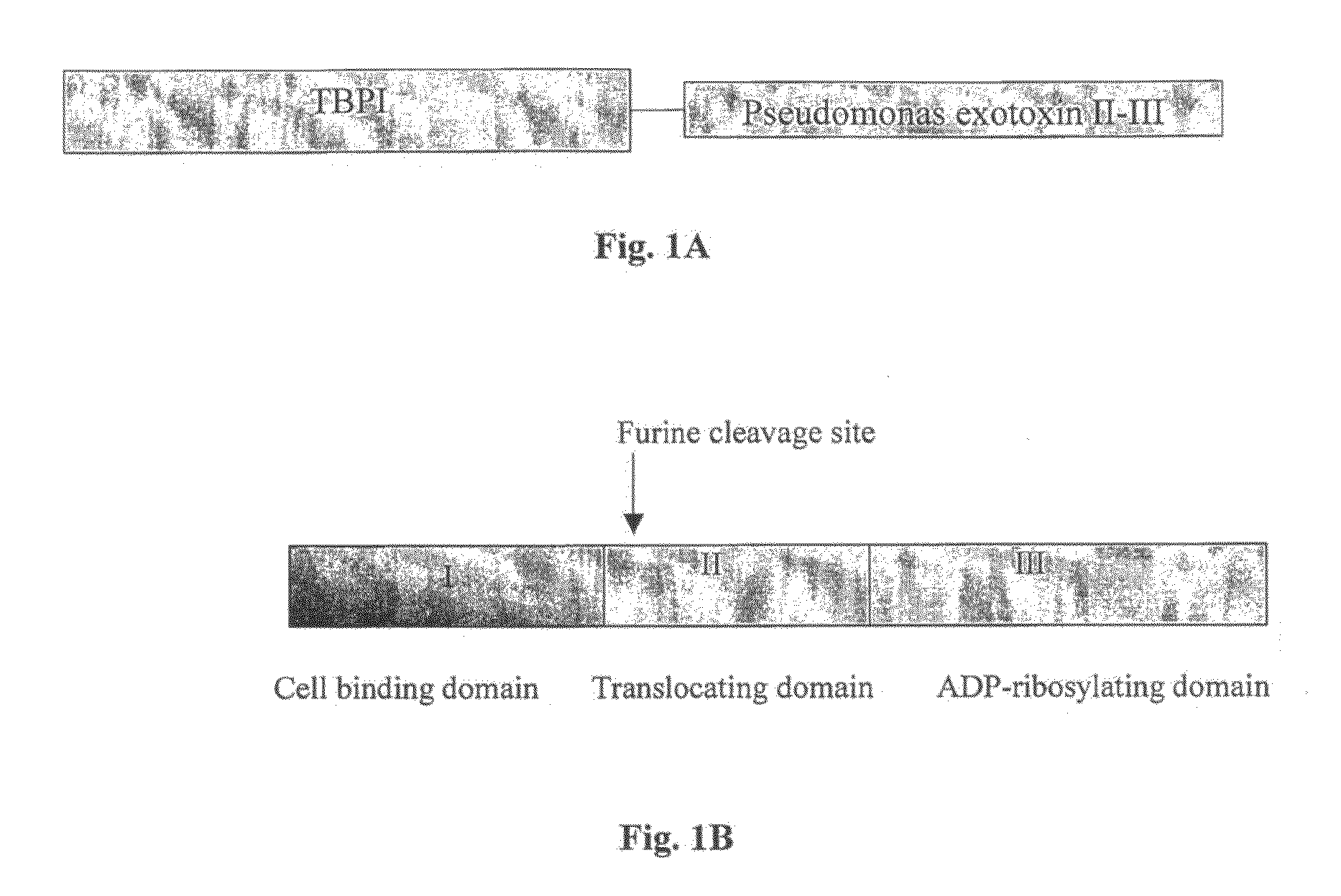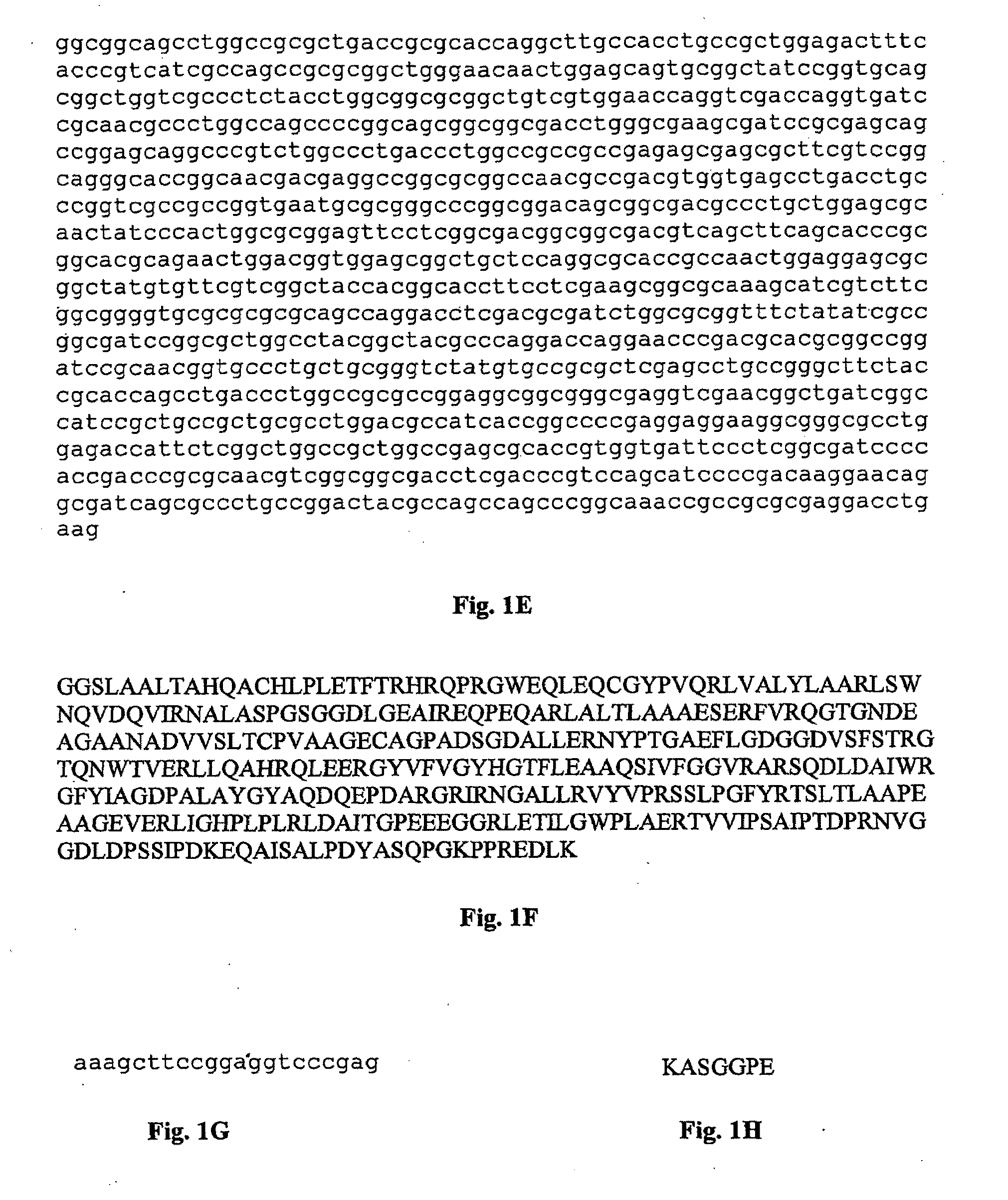Chimeric proteins and uses thereof
a technology of chimeric proteins and proteins, applied in the field of chimeric proteins, can solve the problems of evoke an immune response in the patient, large damage, and high involvement in the screening process of such antibodies,
- Summary
- Abstract
- Description
- Claims
- Application Information
AI Technical Summary
Benefits of technology
Problems solved by technology
Method used
Image
Examples
example 1
Construction of a Chimeric Gene (Referred Herein TBP-PE) Comprising the Extracellular Portion of the p55 TNF Receptor (TBPI) and a 40 kDa Fragment of Pseudomonas exotoxin (PE), Containing Domains II, Ib and III of Pseudomonas exotoxin
[0127]In order to prepare the chimeric TBP-PE gene (FIG. 1C, SEQ ID NO: 1), as schematically represented on FIG. 1A; each of the DNA fragments encoding TBP (extracellular portion of the p55 TNF receptor) and PE (a 40 kDa fragment of Pseudomonas exotoxin), containing domains II, Ib and III of Pseudomonas exotoxin) were amplified by polymerase chain reaction (PCR) amplification and fused.
[0128]The amino acid sequence of the soluble form of the p55 TNF receptor (TNFRSF1A, Genbank ID M75866) corresponds to that of the major species of the soluble form of this receptor (TBPI) that had been isolated from human urine (U.S. Pat. No. 5,811,261) and it extends from Asp 41 to Asn 201 in the receptor's extracellular domain (Swiss-Prot-accession number: P19438).
[012...
example 2
Production of TBP-PE in Bacterial Cells
[0137]The bacterial strain BL21 (DE3) pLys, containing the TPB-PE vector (pTBP-PE) was cultured in 1 liter of Super broth with 0.4% glucose, 1.68 mM MgSO4 and 100 μg / ml Ampicillin at 37° C. When absorbance at 600 nm reached 2.6, induction of recombinant protein expression was carried out by IPTG (isopropyl beta-D-thio-galactopyranoside) addition to the culture at a final concentration of 1 mM for about 90 minutes. Bacterial cells were harvested from the culture by centrifugation at 7500×g at 4° C. for 10 minutes and the cell pellet was kept frozen at −70° C. for 16 hours.
[0138]The frozen cell pellet was thawed on ice and re-suspended in 220 ml of buffer A [Phosphate buffered Saline without calcium and magnesium (“PBS w / o”), 50 mM EDTA, 5 mM MgSO4, four tablets of complete protease cocktail (Roche), 30 mg / l DNaseI (Sigma)].
[0139]In order to breakdown cell clumps, the bacterial suspension was passed through an intradiscal 18G needle. Bacterial ly...
example 3
Affinity Purification of TBP-PE Chimera
[0146]The TBP-PE chimera was purified from the refolded crude extract comprising TBP-PE of Example 2 by affinity chromatography with an anti TBP-I cross-linked column.
[0147]For preparing the anti TBP-I cross-linked column, 2 mls. of protein G-Sepharose (or protein A for rabbit antibodies) (Amersham) were washed with 50 ml PBS (pH 7.5-8.0) for 3 times. 6 mg of monoclonal anti-TBPI antibody clone 20.11 (Engelmann et al. JBC 265 (24) 14497-504 1990) in 20 ml PBS, pH 7.5-8.0 (400 μl of stock 16.7 mg / ml) were added to the washed protein G-Sepharose, incubated at about 22° C. for 1.5 hours by shaking and washed twice with 10 volumes of 0.2M borate buffer (pH9.0 with NaOH). 100 μg crosslinker (DMP, PIERCE) (about 30-fold molar excess of crosslinker over the antibodies) in 4 ml borate buffer was added to the G-sepharose and antibody solution and incubated for 30 minutes. 20 ml of 50 mM Tris, pH 8.0 were added in order to stop the reaction and the solut...
PUM
| Property | Measurement | Unit |
|---|---|---|
| Cell death | aaaaa | aaaaa |
Abstract
Description
Claims
Application Information
 Login to View More
Login to View More - R&D
- Intellectual Property
- Life Sciences
- Materials
- Tech Scout
- Unparalleled Data Quality
- Higher Quality Content
- 60% Fewer Hallucinations
Browse by: Latest US Patents, China's latest patents, Technical Efficacy Thesaurus, Application Domain, Technology Topic, Popular Technical Reports.
© 2025 PatSnap. All rights reserved.Legal|Privacy policy|Modern Slavery Act Transparency Statement|Sitemap|About US| Contact US: help@patsnap.com



